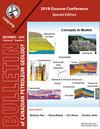Comparison of McMurray Formation (Lower Cretaceous) and Grosmont Formation (Upper Devonian) bitumen reservoirs with some speculations, from a geological perspective, on the future of Canadian thermal recovery
Q3 Earth and Planetary Sciences
引用次数: 3
Abstract
Abstract Using the data from over 8000 wells augmented by seismic and thermal response information, a comparison of McMurray Formation (Cretaceous) and Grosmont C member (Devonian) thermal recovery reservoirs of northeastern Alberta is provided along with a discussion of reservoir performance to date. Fluvial-estuarine McMurray Formation reservoirs perform best where bitumen-charged homogeneous lenticular sandstones at least 20 metres thick are found. These deposits are relatively rare as the formation is characterized by endemic heterogeneity mainly in the form of inclined heterolithic stratification (IHS). Most of the best McMurray steam-assisted gravity drainage (SAGD) reservoirs appear to be currently on-line and produce approximately 113 000 m3/day of bitumen from fourteen projects. Platform carbonate Grosmont C successions are blanket deposits 32–35 metres thick, with bitumen columns typically 15–24 metres thick, and are characterized by consistent reservoir properties facilitated by pervasive multi-scale fracturing. Although no reserves have yet to be assigned to Alberta’s bitumen-bearing carbonates by the province, recent pilot results derived from cyclic steam stimulation (CSS) operations suggest that Grosmont C reservoir performance could ultimately prove to be competitive with superior McMurray SAGD reservoirs. Under current technological and economic conditions, McMurray SAGD reservoirs appear incapable of providing the 15.9 billion m3 of in-situ bitumen reserves (59% of Canada’s total oil reserves) ascribed to this formation by the province of Alberta as only circa 6 billion m3 of oil-in place appears to reside within optimal reservoirs (i.e. those reservoirs at least 20 metres thick with average porosity and oil saturation values of 33% and 80%, respectively). Barring future technological breakthroughs and, or, economic improvements, future commercial development of both the Grosmont C and other carbonate reservoirs might be needed to make up for some of the potential reserve shortfall associated with McMurray Formation SAGD reservoirs.McMurray组(下白垩统)和Grosmont组(上泥盆统)沥青储层的比较,并从地质角度对加拿大热采的未来进行了一些推测
利用8000多口井的数据,结合地震和热响应信息,对Alberta东北部McMurray组(白垩纪)和Grosmont C段(泥盆纪)热采油藏进行了比较,并讨论了迄今为止油藏的表现。在含沥青均匀透镜状砂岩至少20米厚的河流河口麦克默里组储层表现最好。这些矿床相对较少,因为地层具有地方性非均质性,主要表现为斜异石器层结(IHS)。目前,大多数最好的McMurray蒸汽辅助重力排水(SAGD)油藏似乎已经上线,14个项目的沥青产量约为11.3万立方米/天。台地碳酸盐岩Grosmont C层序为厚32-35米的毯状沉积,沥青柱厚15-24米,普遍存在多尺度压裂,储层物性一致。尽管阿尔伯塔省还没有为含沥青碳酸盐岩分配储量,但最近从循环蒸汽增产(CSS)操作中得出的试验结果表明,Grosmont C油藏的性能最终可以证明与McMurray SAGD油藏相竞争。在目前的技术和经济条件下,McMurray SAGD储层似乎无法提供159亿立方米的沥青储量(占加拿大总石油储量的59%),因为只有大约60亿立方米的石油存在于最佳储层中(即厚度至少20米,平均孔隙度和含油饱和度分别为33%和80%的储层)。除非未来的技术突破或经济改善,否则Grosmont C和其他碳酸盐岩储层的未来商业开发可能需要弥补McMurray组SAGD储层的一些潜在储量不足。
本文章由计算机程序翻译,如有差异,请以英文原文为准。
求助全文
约1分钟内获得全文
求助全文
来源期刊

Bullentin of Canadian Petroleum Geology
Earth and Planetary Sciences-Geochemistry and Petrology
CiteScore
2.50
自引率
0.00%
发文量
0
期刊介绍:
The Bulletin of Canadian Petroleum Geology is a peer-reviewed scientific journal published four times a year. Founded in 1953, the BCPG aims to be the journal of record for papers dealing with all aspects of petroleum geology, broadly conceived, with a particularly (though not exclusively) Canadian focus. International submissions are encouraged, especially where a connection can be made to Canadian examples.
 求助内容:
求助内容: 应助结果提醒方式:
应助结果提醒方式:


